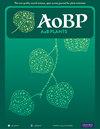Guiding Seed Movement: Environmental Heterogeneity Drives Genetic Differentiation in Plathymenia reticulata Benth., Providing Insights for Restoration
IF 2.4
3区 生物学
Q2 ECOLOGY
引用次数: 0
Abstract
Forest and landscape restoration is one of the main strategies for overcoming the environmental crisis. This activity is particularly relevant for biodiversity-rich areas threatened by deforestation, such as tropical forests. Efficient long-term restoration requires understanding the composition and genetic structure of native populations, as well as the factors that influence these genetic components. This is because these populations serve as the seed sources and, therefore, the gene reservoirs for areas under restoration. In the present study, we investigated the influence of environmental, climatic, and spatial distance factors on the genetic patterns of Plathymenia reticulata Benth., aiming to support seed translocation strategies for restoration areas. We collected plant samples from nine populations of P. reticulata in the state of Bahia, Brazil, located in areas of Atlantic Forest and Savanna, across four climatic types, and genotyped them using nine nuclear and three chloroplast microsatellite markers. The populations of P. reticulata evaluated generally showed low to moderate genotypic variability and low haplotypic diversity. The populations within the Savanna phytophysiognomy showed values above average for six of the eight evaluated genetic diversity parameters. Using this classification based on phytophysiognomy demonstrated a high predictive power for genetic differentiation in P. reticulata. Furthermore, the interplay of climate, soil, and geographic distance influenced the spread of alleles across the landscape. Based on our findings, we propose seed translocation, taking into account the biome, with restricted use of seed sources acquired or collected from the same environment as the areas to be restored (Savanna or Atlantic Forest).引导种子运动:环境异质性驱动网纹蝶(Plathymenia reticulata Benth.)的遗传分化,为恢复提供启示
恢复森林和景观是克服环境危机的主要战略之一。这项活动对于受到砍伐森林威胁的生物多样性丰富地区(如热带森林)尤为重要。有效的长期恢复需要了解本地种群的组成和遗传结构,以及影响这些遗传成分的因素。这是因为这些种群是种子来源,因此也是恢复地区的基因库。在本研究中,我们调查了环境、气候和空间距离等因素对网纹石莲花(Plathymenia reticulata Benth.)遗传模式的影响,旨在为恢复地区的种子迁移策略提供支持。我们采集了巴西巴伊亚州大西洋森林和热带稀树草原地区四个气候类型的九个P. reticulata种群的植物样本,并使用九个核微卫星标记和三个叶绿体微卫星标记对它们进行了基因分型。所评估的 P. reticulata 种群普遍表现出低到中等的基因型变异性和较低的单倍型多样性。在 8 个评估的遗传多样性参数中,热带稀树草原植物学中的种群有 6 个参数值高于平均值。这种基于植物生理学的分类方法对网纹草的遗传分化具有很高的预测能力。此外,气候、土壤和地理距离的相互作用也影响了等位基因在景观中的传播。根据我们的研究结果,我们建议在考虑到生物群落的情况下进行种子转移,并限制使用从与待恢复地区(热带草原或大西洋森林)相同的环境中获取或收集的种子来源。
本文章由计算机程序翻译,如有差异,请以英文原文为准。
求助全文
约1分钟内获得全文
求助全文
来源期刊

AoB Plants
PLANT SCIENCES-
CiteScore
4.80
自引率
0.00%
发文量
54
审稿时长
20 weeks
期刊介绍:
AoB PLANTS is an open-access, online journal that has been publishing peer-reviewed articles since 2010, with an emphasis on all aspects of environmental and evolutionary plant biology. Published by Oxford University Press, this journal is dedicated to rapid publication of research articles, reviews, commentaries and short communications. The taxonomic scope of the journal spans the full gamut of vascular and non-vascular plants, as well as other taxa that impact these organisms. AoB PLANTS provides a fast-track pathway for publishing high-quality research in an open-access environment, where papers are available online to anyone, anywhere free of charge.
 求助内容:
求助内容: 应助结果提醒方式:
应助结果提醒方式:


